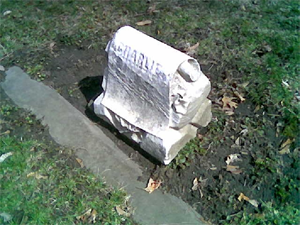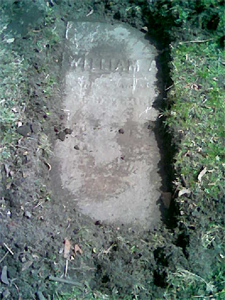John Beverlin 1813 - 1891
Gracia Beverlin 1816 - 1893
Former Ohio City Mayor and a Buckeye of the Staunchest Kind
From the Cleveland Leader, January 4, 1893
Mrs. Gracia Beverlin, an old resident of Cleveland, very well known on the West Side, died at Oakland, Cal., on January 3. The funeral occurred in this city on Thursday. Mrs. Beverlin was seventy-seven years old. Her husband, John Beverlin, who died three years ago, was a leading businessman on the West Side when it was Ohio City. He was the kind of man of whom it was said, "his word is as good as his bond." For sixty-two years Mrs. Beverlin lived in Ohio City and Cleveland, fifty-two years of that time on the Beverlin property at the corner of State and Clinton streets. For fifty years she was a member of St. John's Episcopal Church. Last fall she went to California to visit her sister. A short time ago she went to a hospital in Oakland and had an operation performed on one of her eyes by an eminent oculist. She died there of heart failure, supposed to have been produced by the shock. Only one child survives her, Clarence Beverlin of Huron, Ohio."
Another bit of information regarding Gracia Beverlin can be found in the 1896 History of Cuyahoga County Cities:"Although of pure Yankee descent and born in Massachusetts, Miss Gracia M. Wilcox became a Buckeye of the staunchest kind. When quite young she removed to Brecksville, Ohio, making the journey in an ox team with her parents, Josiah and Abigail Wilcox. In 1837 she came to Cleveland, married Mr. John Beverlin who, in 1848, was Mayor of "the City of Ohio." For a time they resided on Detroit street hill, overlooking the river, a most picturesque site; then built a pleasant home on the corner of State and Clinton streets, where was celebrated their golden wedding. She was a patriotic woman, and devoted to the interest of her church. Her daughter, Julia, married Mr. Charles Standart, a son of Needham and Naomi Standart."
It was around 1841 that John and Gracia purchased property at the corner of Clinton and State (West 29th) Streets. In 1855 they built the home that still stands on that corner, an imposing Italianate-style home at 2901 Clinton Avenue. Later, at about the time that John died in 1891, there was some remodeling done to the house which it is believed included the addition of the faux Second Empire-style windows that, somewhat crudely, adorn the roof above the cornice. The Beverlins lived in that home until their deaths. In 1871 they erected a second home on their property, a delightfully detailed Italianate-style house which, today, bears the address 2913 Clinton. There is no record of who built the house but it may have been the Beverlins' son, Clarence, who spent most of his life as a house carpenter.
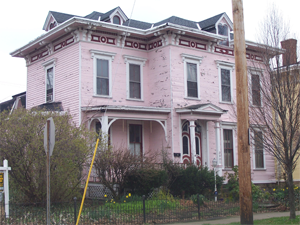
John and Gracia gave birth to five children, William (1840-1848), Charles (born 1848), John (1849-1872), Clarence (1852-1904), and Julia (dates not known). William, Charles, John and Clarence are buried with their parents in Section D, lot 15, at Monroe Street Cemetery.
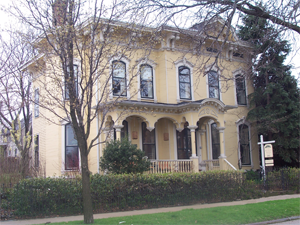
While Gracia was a product of New England, as was so frequently the birthplace of the pioneers who came to Ohio City, John Beverlin was from Pennsylvania where he was born in 1813. John had arrived in Ohio City by 1834 and took up the trade of tailor. He is shown in the 1837 Ohio City Directory with a tailoring business on Detroit Street, where it is believed he worked and lived. The business name was Beverlin & Coy and they are listed as "tailors" but their business was better known as "merchant Tailor" and was shown as such in later city directories. The largely obsolete term "merchant tailor" describes a business person who trades in textiles. John maintained his business on Detroit Street until around 1867 when he moved his business to 125 Bank Street. This location made good business sense since being a merchant tailor meant that you were a cloth merchant buying products from cloth manufacturers (or "clothiers") and selling to clothing or drapery manufacturers or upholsterers and, what we know today as the Warehouse District was developing as an apparel manufacturing area.
John served as an Ohio City councilman in 1846 and 1847 and was then elected Mayor in 1848. John's terms in office were during a tumultuous period in American history. The Mexican War (See the Postlude for a description of this conflict) was begun in 1846 during the presidential administration of James K. Polk. Polk was an expansionist who, by the end of his time in office, had added New Mexico and California to the land holdings of the United States. The headlines in the True Democrat and the Cleveland Leader throughout 1848 were focused on the War, slavery and abolition. The True Democrat, a morning daily newspaper published in Cleveland by E. S. Hamlin and E. L. Stevens, listed the National Policy which they, and many democrats, espoused -
- The exemption of the National Government from all support of slavery.
- No more Slave Territory.
- No more Slave States.
- A Tariff for revenue, equally protecting all interests.
- A sound and uniform Currency.
- The improvement of our Harbors and Rivers by the National Government
- Restriction of executive patronage, and the Veto Power.
- The support of such men only, for office, as give satisfactory evidence that they will support these principles.
1848 was also an election year. The result of that process was the election of "Old Rough and Ready", Zachary Taylor, who had become a national figure during the Mexican War. Abolitionists, who had years earlier formed their own political party, the Liberty Party, and made two unsuccessful attempts at the presidency, met during 1848 with Martin Van Buren who wanted to make another run for president. The result of that meeting was a presidential platform that reflected the National Policy published by the True Democrat and concluded with the slogan "Free Soil, Free Speech, Free Labor, Free Men."
The Free Soil movement found many followers in Ohio City and Cleveland, where the Underground Railroad had established its station to Freedom, and men banded together to endorse and pursue the tenets of that platform. The True Democrat, on September 25, 1848, reported:
"Enthusiastic Meeting in Ohio City - At a meeting of the FREE SOILERS of Ohio City, in the City Hall, on the evening of Sept. 22d. . . . On motion of John Cody, a committee of three was appointed to nominate officers for a permanent Free Soil Club. The Committee, after a short absence, reported the names of the following gentlemen:
For President - E.L. Stevens
For Vice Presidents = E. Rogers, Samuel Turner
Secretary - Charles H. Churchill
Executive Committee - John Beverlin, Lyman Crowl, Capt. DeGroat
. . . Dr. Finney, editor of the Spirit of Freedom was called out for a speech, and addressed the large audience for an hour in his peculiarly interesting and eloquent manner. His life-like descriptions of the positions of Cass and Taylor, and his well-timed anecdotes, drew forth thunders of applause. . . After three long and loud cheers for Free Soil, Free Speech and Free Men, the meeting adjourned."
The Cleveland City Directories from 1873 and thereafter do not show an occupation for John Beverlin. In 1873 he was 60 years old and a wealthy man. The 1870 census shows that John owned real estate valued at $12,000 and had a personal estate of $4,000. Even if these figures were somewhat inflated and rounded off, these were substantial sums of money at that time period, so it is reasonable to assume that financially he had been able to retire from the merchant tailor business. John continued to live in the house on the corner of Clinton and State and on Monday, May 18, 1891 died there. His cause of death as shown in the cemetery records was "dropsy." Dropsy, or edema as it is more commonly called today, is an abnormal accumulation of fluid beneath the skin, or in one or more cavities of the body. Dropsy, while in and of itself, is not normally fatal, the condition can occur as a result of heart, lung or kidney problems. John's funeral took place in his house which, by then, bore the address of 43 Clinton Street; his burial was "private."
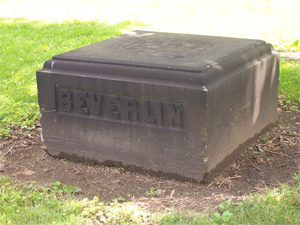
Historic cemeteries can, at times, be very frustrating. Missing or incomplete records, damaged or missing grave markers, headstones buried beneath the grass, and information on markers that has been eroded by time and weather often leave one wondering about a gravesite. The Beverlin gravesite represents one of those times. The base of what must have been an impressive monument is all that is left. It bears the family name and gives evidence that there had been more to the monument than meets the eye today but what the monument had been originally may never be discovered. William Beverlin's headstone is buried beneath the grass. Charles Beverlin's stone is so weatherworn that the information that may have been on it, other than "Charlie" is not decipherable.
John Beverlin is one of six former Mayors of Ohio City originally buried at Monroe Street Cemetery. The others are Josiah Barber (moved to Riverside Cemetery), Richard Lord, Needham Standart, David Griffith and William Bainbridge Castle (moved to Lakeview Cemetery). All of these men are/were buried near one another in the northeast portion of the cemetery.
